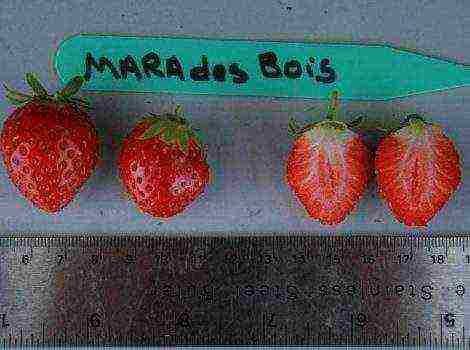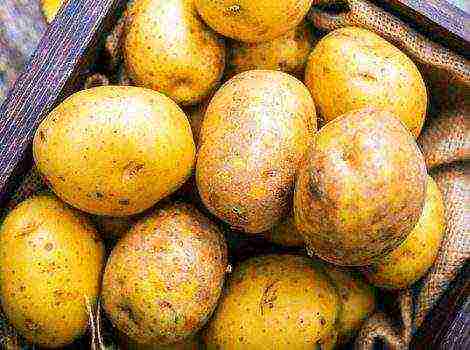Content
- 1 Classification of varieties by traits
- 2 Apple trees for the middle lane
- 2.1 Apple-tree Elena
- 2.2 Apple Champion
- 2.3 Apple-tree Orlovskoe striped
- 2.4 Apple tree Sun
- 2.5 Apple tree Streyfling
- 2.6 Apple tree Idared
- 2.7 Apple-tree Belfer-Chinese
- 2.8 Apple-tree Borovinka
- 2.9 Apple tree Gloucester
- 2.10 Apple tree Kovalenkovskoe
- 2.11 Apple tree Jonathan
- 2.12 Apple tree Florina
- 2.13 Apple Royalty
- 2.14 Apple varieties at their summer cottage - video
- 3 The best winter varieties of apple trees for the Moscow region and central Russia: photo and description
- 4 What popular winter varieties of apple trees are best planted in the middle lane
- 5 The best autumn varieties of apple trees for the Moscow region and the middle lane (with photo)
- 6 The most productive autumn varieties of apple trees: description with photos
- 7 What good varieties of autumn apple trees are better to plant in the suburbs
- 8 The best summer varieties of apple trees for the Moscow region and the middle lane
- 9 What other varieties of summer apple trees can be planted on the site

Those varieties of apple trees that were popular with our grandparents are gradually becoming a thing of the past. Nowadays you rarely see in the gardens Grushovka Moskovskaya, Korobovka, Aport, Borovinka, Kitaika Zolotaya early, and even Antonovka is gradually losing ground. Despite the pleasant taste and other advantages, these varieties are in many ways inferior to those that have been bred over the past few years.
Varieties with which it's time to say goodbye
New varieties of apple trees with improved characteristics of yield, winter hardiness and resistance to the most common diseases appear in the State Register every year. Some of the currently popular varieties of apple trees are distinguished by absolute immunity to scab, others are valued for their excellent keeping quality and shelf life, while others attract with their beautiful appearance and wonderful dessert taste.
It is not at all necessary to plant in your garden exclusively seedlings of those varieties that have proven themselves well twenty or thirty years ago. Try to replace them with new varieties that domestic gardeners have already fallen in love with. It is unlikely that this choice will disappoint you!
Video about apple varieties
How to deal with various diseases of apple trees from year to year, worry about how the trees will survive the winter, and unsuccessfully try to increase the yield, isn't it better to get rid of old varieties? Let's figure out which apple trees you can refuse without regret.
For example, in an old variety Cinnamon striped the apples, although tasty, are not very attractive in appearance, and the yields are not high enough. And apple varieties Autumn striped grow too large, start bearing fruit late and are poorly drought tolerant. Instead of these varieties, it is better to plant the Orlovskoe striped variety with mouth-watering tasty apples and good yield, or Cinnamon new - a variety that starts bearing early, productive and is immune to scab.
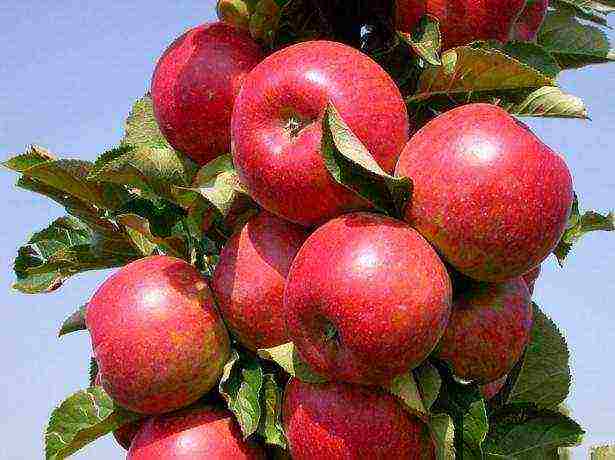
Canadian Quinty is not winter-hardy and scab resistant
Quinty and Folding - summer varieties of apple trees, which are also not very suitable for cultivation. Canadian Quinti is not winter-hardy and scab resistant, Papirovka does not bear fruit every year, besides, apples are very sour, becoming tasteless when overripe, and do not tolerate transportation well. Gardeners preferred Canadian Melba with delicious fruits to these varieties. And the new varieties Early Aloe and Orlinka are not only high-yielding and fast-growing, but in addition surpass Melba in winter hardiness.
From winter-hardy varieties, you can say goodbye to North synap, giving not particularly tasty fruits, with Pepin with saffron, prone to frequent scab damage, as well as with a variety Memory of Michurin, from which it is difficult to wait for a good harvest. Antonovka ordinary with all its positive qualities, it disappoints gardeners with irregular fruiting, short shelf life of apples and the manifestation of "sunburn" on the fruits during storage. Antonovka has no analogues in terms of fruit taste, but its yield and ripening times can be replaced by such varieties as Legenda, Cinnamon new, Brusnichnoe, Marat Busurin.
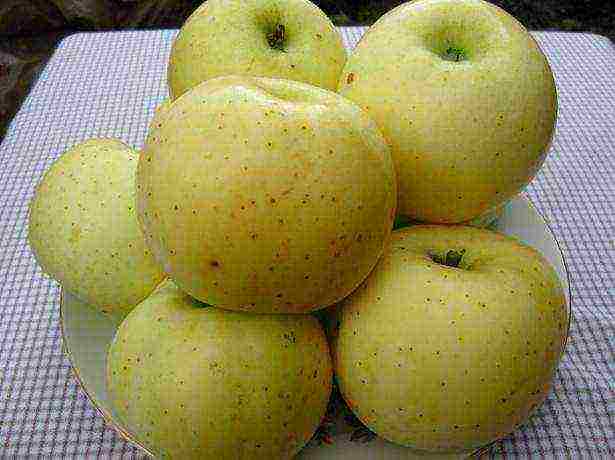
Apple variety "Antonovka ordinary"
The best apple varieties bred in recent years
Through the efforts of breeders, genes for apple tree resistance to the most dangerous diseases and genes for dwarfism were identified - something that was missing in the old varieties of apple trees. So, now in the world there are more than 150 varieties that are immune to scab, which means that they do not require treatment with fungicides.
Among the new varieties of apple trees, the following are distinguished by the best characteristics: Liberty, Golden Resistant, Baritone, Enterprise, Ligol, Krasa Sverdlovsk, Lovely Red, Green Blues, Askolda, Williams Pride, Champion, Capital Red, Radogost, Bullfinch. Most of the listed varieties have already become widespread abroad, but in our country they are only gaining popularity.
Video about early summer varieties of apple trees
We present to your attention a brief description of apple varieties that have already earned the love of Russian gardeners:
- The apple variety Medunitsa has become a real find for those who like sweet apples with a honey flavor. Their taste is most pronounced immediately after removal from the branch; fruits can be stored in the refrigerator until January. Fruiting of apple trees begins already in the fourth year, the yields are plentiful, regular, but with age they become periodic. The Medunitsa variety is immune to rot and scab.
- The Legend apple variety has a sweet, candy taste. Fairly large conical fruits of dark red color have an attractive presentation and the same size. With proper care, the productivity of apple trees is very high, fruiting is annual. Winter hardiness and disease resistance are about the same as that of the best traditional varieties.
- Summer variety Mantet is valued for its early maturity, winter hardiness and good (albeit periodic) yield. Apples begin to ripen from the end of July, they are recommended to be consumed within a month. The pulp of the fruit is very juicy, aromatic, tender, sweetish with sourness. The Mantet variety is unstable to powdery mildew, but it is resistant to scab.
- Until March, the fruits of the Orlik variety, a winter variety of apple trees that ripen by mid-September, can be stored (you can see the photo in the tab to the article). The yellow fruits, covered with a solid red blush, have a harmonious sweet-sour dessert taste and a bright aroma. The winter hardiness of apple trees is sufficient, the resistance to scab is average.
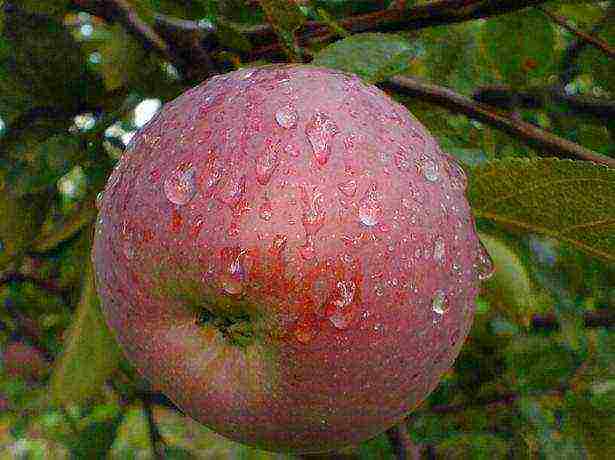
Apple variety "Orlik"
- The late winter apple variety Bogatyr is famous for its high yields. Its large fruits with a pink blush are very aromatic and tasty - their sweetness is successfully complemented by a slight sourness. Fruiting begins in the fifth year after planting.
Particularly noteworthy are the varieties of apple trees included in the State Register that are absolutely resistant to scab: Solnyshko, Imrus, Bolotovskoe, Jubilee of Moscow, Orlovskoe Polesye, Freshness, Kandil Orlovsky, Start, Zdorov'e, Rozhdestvenskoe.
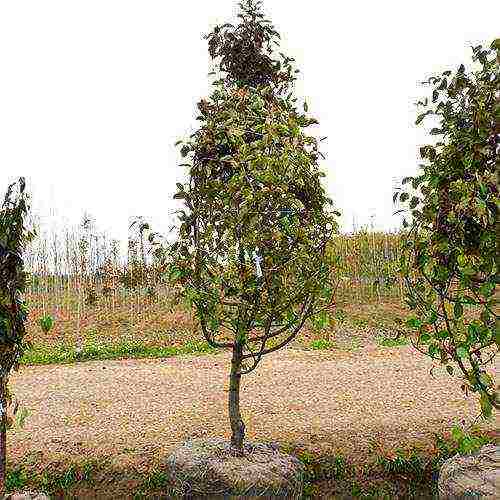 Among the many varieties of apple trees, the gardener will find a fruit tree that meets the needs of an amateur or professional in its characteristics. Breeding work on the breeding of new clones and adaptation of the known ones are carried out in all countries of the Northern Hemisphere. The result is trees with new protective genes and other changes in the structure and fruiting of the apple tree. Let's try to present well-known and diverse varieties of apple trees with photos.
Among the many varieties of apple trees, the gardener will find a fruit tree that meets the needs of an amateur or professional in its characteristics. Breeding work on the breeding of new clones and adaptation of the known ones are carried out in all countries of the Northern Hemisphere. The result is trees with new protective genes and other changes in the structure and fruiting of the apple tree. Let's try to present well-known and diverse varieties of apple trees with photos.
Classification of varieties by traits
In order to determine which seedling your garden needs, you need to know the features of the area. This concept includes:
- what frosts are typical for the area in winter, and how long they last;
- whether there is a prolonged warming with a sharp cold snap in the middle of winter;
- how deep the layer with groundwater lies in the area where the garden grows;
- when stable warm weather sets in;
- how many days the period of positive temperatures lasts during the growing season.
These inputs are used to choose an apple variety for long-term cultivation, and also to choose the taste of the fruit and the storage time.
When laying a garden from any fruit plants, you need to select zoned varieties - recommended for cultivation in this region.
First of all, it is necessary to select varieties that are suitable for winter hardiness. Those apple trees that develop well in central Russia are unsuitable for Eastern Siberia. If at a tender age they can be preserved, then subsequently the apple tree will suffer annually from freezing. You cannot raise a tree. Frost resistance is transmitted genetically during the formation of a variety
Apple tree Ranetka
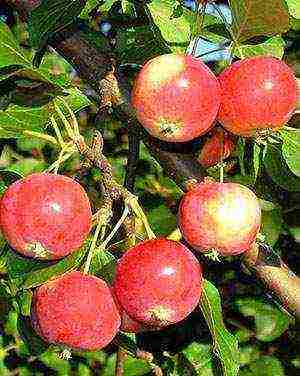 An example of such a tree, which is a small-fruited apple tree, is Ranetka. The ranetka apple tree was obtained by crossing a Siberian small-fruited apple tree with a Chinese one. The apples are small, weighing up to 12 grams, but with a rich taste and smell. Apples do not cause allergies and are included in baby food. They are good in compotes and jam "with legs".
An example of such a tree, which is a small-fruited apple tree, is Ranetka. The ranetka apple tree was obtained by crossing a Siberian small-fruited apple tree with a Chinese one. The apples are small, weighing up to 12 grams, but with a rich taste and smell. Apples do not cause allergies and are included in baby food. They are good in compotes and jam "with legs".
The trees are tall, winter-hardy and give a harvest every year. They do not get scab and are undemanding to the conditions of detention. On the basis of crossing with other varieties, the apple trees Dobrynya, Kitayka Saninskaya, and Purple ranetka were bred.
A sprig of ranetki on a large-fruited apple tree will be a useful and exotic addition.
Spartak variety
 The winter-hardy large-fruited variety Spartak is recommended by the State Register for use in the Middle Urals and Eastern Siberia. This variety is popular in areas where apples were recently imported. The variety was bred at the Samara experimental station by the breeder S.P. Kedrin. Grafted on a Chinese tree or Zhigulevskaya forest apple, Spartak saplings begin to bear fruit even before they are planted in a permanent place. In the photo there is an apple tree Spartak on the described rootstock, ready for planting.
The winter-hardy large-fruited variety Spartak is recommended by the State Register for use in the Middle Urals and Eastern Siberia. This variety is popular in areas where apples were recently imported. The variety was bred at the Samara experimental station by the breeder S.P. Kedrin. Grafted on a Chinese tree or Zhigulevskaya forest apple, Spartak saplings begin to bear fruit even before they are planted in a permanent place. In the photo there is an apple tree Spartak on the described rootstock, ready for planting.
The tree quickly awakens from hibernation and begins an accelerated vegetation. The crop is harvested in early September, but within a month they are gaining taste in the laying place. Apples 90-130 g, there are also large specimens at the beginning of fruiting. The fruits are harvested when they become red-striped. When cultivating, it should be taken into account that the variety is moderately resistant to scab, therefore, preventive treatments during the growing season are mandatory. The branches of a young tree are directed at an acute angle, so a persistent deflection of the skeletal branches to a horizontal position is required, otherwise a break in the future under the weight of the fruit is inevitable.
Apple tree Imant
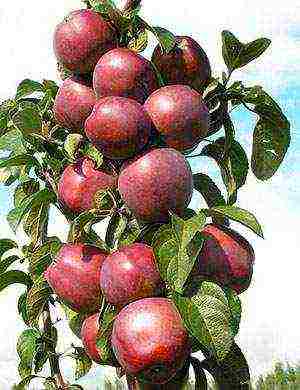 The Imant apple tree will not grow in Siberia, but frost resistance allows it to be cultivated in the climate of the Moscow region. A variety of Belarusian selection, obtained by crossing Anthea and Liberty with the introduction of a gene against scab. You can grow an apple tree on a seed stock and on a clone. In this case, the standard tree begins to bear fruit in the second year after planting. This variety is suitable for industrial use in the Moscow region.
The Imant apple tree will not grow in Siberia, but frost resistance allows it to be cultivated in the climate of the Moscow region. A variety of Belarusian selection, obtained by crossing Anthea and Liberty with the introduction of a gene against scab. You can grow an apple tree on a seed stock and on a clone. In this case, the standard tree begins to bear fruit in the second year after planting. This variety is suitable for industrial use in the Moscow region.
The Imant apple tree is genetically protected from scab, is not very susceptible to stem diseases, cracking and cancer. On a trunk at the age of five, the apple tree gives up to 25 kg of leveled fruits. The apples are large, weighing up to 200 grams. The main color is green, but a superficial red color covers the entire fruit. The taste of the fruit is sweet and sour. Preservation of fruits at low temperatures until June.
Apple-tree Columnar Medoc
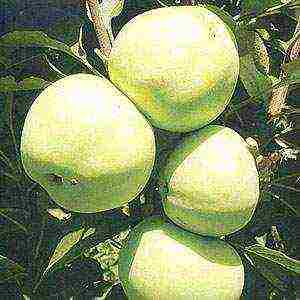 Apple-tree Coloniform Medoc is an autumn variety. The amber apples stuck to the tree are fabulously beautiful. They seem to glow from the honey that has saturated them. The variety is autumn, harvesting is carried out in early September, apples are not stored for long, only a month, but excellent workpieces are obtained from them.Apple trees are demanding on fertility, and depending on nutrition, fruits can weigh from 100 to 250 grams.
Apple-tree Coloniform Medoc is an autumn variety. The amber apples stuck to the tree are fabulously beautiful. They seem to glow from the honey that has saturated them. The variety is autumn, harvesting is carried out in early September, apples are not stored for long, only a month, but excellent workpieces are obtained from them.Apple trees are demanding on fertility, and depending on nutrition, fruits can weigh from 100 to 250 grams.
A tree with a column up to two meters high and no more than 25 centimeters in diameter. With a compact planting, each columnar-shaped apple tree Medoc tree gives up to 10 kg of amber fruits. The tree is early-growing, can yield in the first year after planting. The planting is thickened, 60 cm between the stems and a meter between the rows. The variety tolerates frost at 40 0, but for guaranteed safety it is better to keep a winter shelter. Pests rarely attack Medoc, leaving is easier.
Apple trees for the middle lane
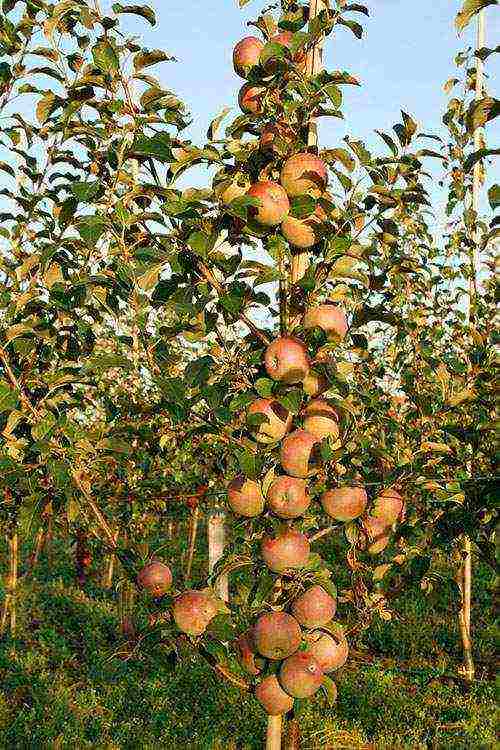 For regionalization in warmer climatic conditions, there are much more varieties of Russian selection, American, French, Baltic. Among them there are species with average winter hardiness, which easily tolerate frosts of 20-30 degrees, tall and medium-sized trees. Therefore, we will present these types of apple trees according to the degree of their early maturity. It is essential to get the harvest 5 or 9 years after the scion. The time to harvest depends on the seed stock or the cultivar grafted onto the clone.
For regionalization in warmer climatic conditions, there are much more varieties of Russian selection, American, French, Baltic. Among them there are species with average winter hardiness, which easily tolerate frosts of 20-30 degrees, tall and medium-sized trees. Therefore, we will present these types of apple trees according to the degree of their early maturity. It is essential to get the harvest 5 or 9 years after the scion. The time to harvest depends on the seed stock or the cultivar grafted onto the clone.
Low-growing compact stems are represented by apple varieties with a photo:
- winter - Sun, Orlovskoe striped;
- mid-season Champion;
- early variety Elena.
In one garden, varieties of different ripening periods are usually cultivated, allowing you to have healing fruits throughout the year. Summer varieties are used within a month after harvest, winter varieties, under appropriate conditions, are stored until mid-summer.
Apple-tree Elena
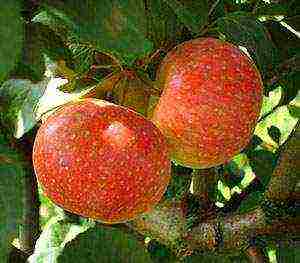 So, Elena's apple tree belongs to summer varieties. The variety of Belarusian selection was accepted for breeding in 2001 and for this region it is a winter-hardy crop with apple flavor on a five-point scale of 4.8 - a very good indicator. Trees of medium height, on dwarf rootstocks bear fruit in the second or third year. The apple tree is scab resistant. The ovary on the Elena apple tree is abundant, thinning is required so as not to overload the tree. In the conditions of Belarus, apples ripen at the end of July.
So, Elena's apple tree belongs to summer varieties. The variety of Belarusian selection was accepted for breeding in 2001 and for this region it is a winter-hardy crop with apple flavor on a five-point scale of 4.8 - a very good indicator. Trees of medium height, on dwarf rootstocks bear fruit in the second or third year. The apple tree is scab resistant. The ovary on the Elena apple tree is abundant, thinning is required so as not to overload the tree. In the conditions of Belarus, apples ripen at the end of July.
Apple Champion
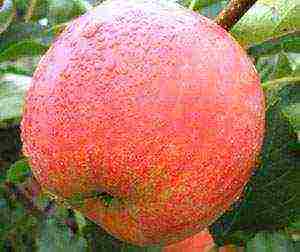 The middle variety is the Champion Apple tree. The apple tree of Czech selection and rapidly spread throughout the European part in the forest-steppes of Ukraine. Even in Ukraine, the variety needs to be insulated for the winter.
The middle variety is the Champion Apple tree. The apple tree of Czech selection and rapidly spread throughout the European part in the forest-steppes of Ukraine. Even in Ukraine, the variety needs to be insulated for the winter.
The tree is not tall, the annual growth is small. Resistance to diseases and pests is average, high to scab. The variety is fast-growing and requires the presence of a pollinator for good fruiting. Fruiting is annual, abundant. Lined apples, 190 grams each, are harvested in September. The harvest is stored for more than six months. The taste of red fruits is sweet and sour.
Apple-tree Orlovskoe striped
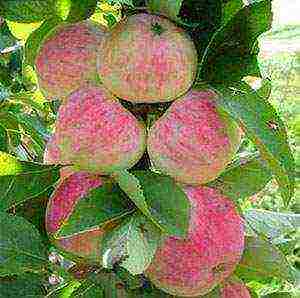 The winter variety is the Orlovskoe striped apple tree. The variety was bred and entered the register as recommended for industrial use in 1986. For central Russia, the Oryol region, the winter hardiness of the variety is good. The variety is considered elite in terms of yield and taste of fruits. The only drawback is that apples have thin skin and special care is required when harvesting and transporting. The variety is resistant to scab and begins to bear fruit in 3-4 years.
The winter variety is the Orlovskoe striped apple tree. The variety was bred and entered the register as recommended for industrial use in 1986. For central Russia, the Oryol region, the winter hardiness of the variety is good. The variety is considered elite in terms of yield and taste of fruits. The only drawback is that apples have thin skin and special care is required when harvesting and transporting. The variety is resistant to scab and begins to bear fruit in 3-4 years.
Apple tree Sun
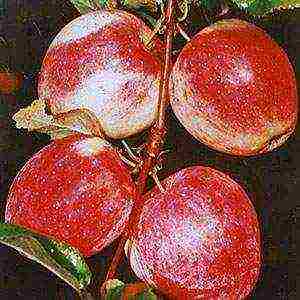 The winter apple tree Solnyshko received a residence permit in the gardens of central Russia in 2001. But the winter hardiness of the variety is excellent. Freezing the branches at 40 0 did not have any consequences. Suitable for growing on dwarf rootstocks and itself has a short stature. A fast growing variety suitable for industrial gardens. The Sun apple tree is immune to scab at the genetic level. The fruits ripen in the second half of September and are stored until the New Year.
The winter apple tree Solnyshko received a residence permit in the gardens of central Russia in 2001. But the winter hardiness of the variety is excellent. Freezing the branches at 40 0 did not have any consequences. Suitable for growing on dwarf rootstocks and itself has a short stature. A fast growing variety suitable for industrial gardens. The Sun apple tree is immune to scab at the genetic level. The fruits ripen in the second half of September and are stored until the New Year.
Apple tree Streyfling
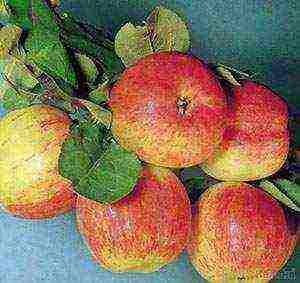 Tall varieties are the oldest and have long established themselves as reliable. They serve as mother material for breeding new varieties of apple trees. Among them, it is impossible to pass by the Baltic apple variety Streifling. A huge tree 8 meters high and with the same spreading crown from a distance resembles an inverted cauldron. The tree is widespread in the middle zone with low winter temperatures.Apples are large up to 200 grams. The apple tree loves moisture and does not tolerate drought. Apples are harvested in September, stored for 2-3 months. Fruits are fastened well and, with a delay in harvesting, they do not crumble, but they are stored worse. The winter hardiness of the Streyfling apple tree is average, but sufficient for its habitat. The apple tree does not bear fruit every year.
Tall varieties are the oldest and have long established themselves as reliable. They serve as mother material for breeding new varieties of apple trees. Among them, it is impossible to pass by the Baltic apple variety Streifling. A huge tree 8 meters high and with the same spreading crown from a distance resembles an inverted cauldron. The tree is widespread in the middle zone with low winter temperatures.Apples are large up to 200 grams. The apple tree loves moisture and does not tolerate drought. Apples are harvested in September, stored for 2-3 months. Fruits are fastened well and, with a delay in harvesting, they do not crumble, but they are stored worse. The winter hardiness of the Streyfling apple tree is average, but sufficient for its habitat. The apple tree does not bear fruit every year.
Apple tree Idared
 The representative of the American variety is the Idared apple tree. The winter variety is grown in the south of our country and in Ukraine. The variety is intended for export deliveries for the commercial quality of the fruit. Filmed in September, they retain their commercial qualities for six months. The tree is not resistant to scab disease.
The representative of the American variety is the Idared apple tree. The winter variety is grown in the south of our country and in Ukraine. The variety is intended for export deliveries for the commercial quality of the fruit. Filmed in September, they retain their commercial qualities for six months. The tree is not resistant to scab disease.
Apple-tree Belfer-Chinese
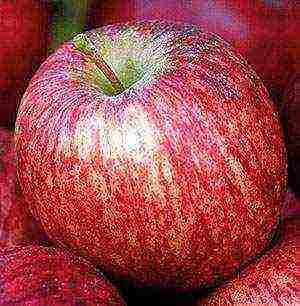 Apple-tree Belfer-Kitayka is a pre-war variety of Michurinsk breeding. A tall variety with late autumn apples of excellent taste gave rise to many varieties of domestic selection. Fruiting of this apple tree begins in the eighth or ninth year. The apple tree requires protection from pests and scab, has a low winter hardiness in the Michurinsky region.
Apple-tree Belfer-Kitayka is a pre-war variety of Michurinsk breeding. A tall variety with late autumn apples of excellent taste gave rise to many varieties of domestic selection. Fruiting of this apple tree begins in the eighth or ninth year. The apple tree requires protection from pests and scab, has a low winter hardiness in the Michurinsky region.
Apple-tree Borovinka
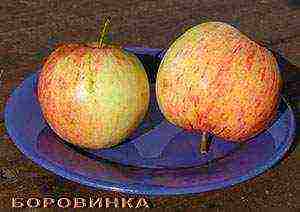 The Borovinka apple variety belongs to the old varieties of early ripening. This is a relatively early fruiting variety. But his apples are not large, only 90 grams, the taste is average, the shelf life is only one month. In addition, the fruits and leaves of the apple tree of this variety are strongly affected by scab.
The Borovinka apple variety belongs to the old varieties of early ripening. This is a relatively early fruiting variety. But his apples are not large, only 90 grams, the taste is average, the shelf life is only one month. In addition, the fruits and leaves of the apple tree of this variety are strongly affected by scab.
Apple tree Gloucester
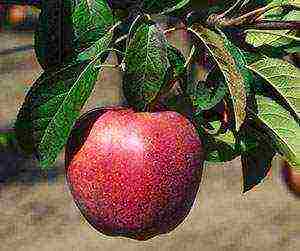 The Gloucester apple tree can grow on a dwarf rootstock or be a large, spreading tree. A seedling on a seedling rootstock is characterized by long development until the first harvest. Therefore, maturity can be accelerated artificially:
The Gloucester apple tree can grow on a dwarf rootstock or be a large, spreading tree. A seedling on a seedling rootstock is characterized by long development until the first harvest. Therefore, maturity can be accelerated artificially:
- crown formation with bending of branches to a horizontal position;
- the use of special drugs that inhibit the summer growth of branches;
- with the exception of the nitrogen component from top dressing.
On a semi-dwarf rootstock, the apple tree begins to bear fruit in the fourth year. The fruits are large, up to 200 grams. The taste of apples is high, slightly sour. They can be stored for up to 4 months and are not injured during transportation.
Apple tree Kovalenkovskoe
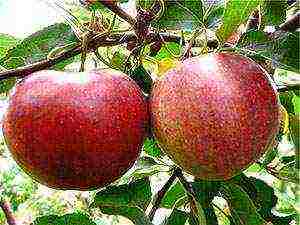 The large-fruited Kovalenkovskoe apple tree was bred by a breeder of Belarus. The variety is medium-sized and fast-growing. On a dwarf rootstock, it develops into an adult tree in the third year. The fruits of the summer ripening period, the first harvest is removed by the Apple Savior. Apples acquire their taste after a two-week rest after harvesting. Fruits do not crumble, ripening is stretched. The variety is assigned to the Central Region of Russia and is distributed in the homeland of creation.
The large-fruited Kovalenkovskoe apple tree was bred by a breeder of Belarus. The variety is medium-sized and fast-growing. On a dwarf rootstock, it develops into an adult tree in the third year. The fruits of the summer ripening period, the first harvest is removed by the Apple Savior. Apples acquire their taste after a two-week rest after harvesting. Fruits do not crumble, ripening is stretched. The variety is assigned to the Central Region of Russia and is distributed in the homeland of creation.
Apple tree Jonathan
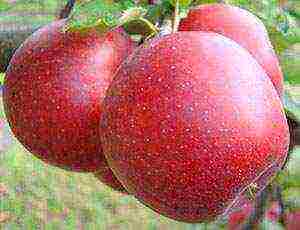 Apple tree Jonathan refers to an American guest on our continent. In the conditions of Russia, this apple variety is grown only in the North Caucasus. Fruiting on medium rootstocks after 5 years. The apple tree gives fruits annually and the maximum yield from one apple tree is 490 kg. The apple tree is scab resistant and is often sick with powdery mildew. The fruits have excellent dessert taste and long shelf life. The well-known apple variety Idared is bred on the basis of Jonathan.
Apple tree Jonathan refers to an American guest on our continent. In the conditions of Russia, this apple variety is grown only in the North Caucasus. Fruiting on medium rootstocks after 5 years. The apple tree gives fruits annually and the maximum yield from one apple tree is 490 kg. The apple tree is scab resistant and is often sick with powdery mildew. The fruits have excellent dessert taste and long shelf life. The well-known apple variety Idared is bred on the basis of Jonathan.
Apple tree Florina
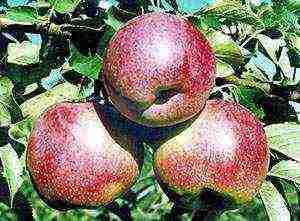 The French guest, the apple-tree Florina, took her place in the steppes and forest-steppes. Winter variety, sweet apples. Medium-sized tree with a rounded crown. The height of the tree is up to 5 meters. The tree blooms for a long time and has time to perfectly pollinate. Therefore, fruit set is good. Harvested in October. Apples keep well and only get sweeter over time. The variety is resistant to scab and bacterial diseases.
The French guest, the apple-tree Florina, took her place in the steppes and forest-steppes. Winter variety, sweet apples. Medium-sized tree with a rounded crown. The height of the tree is up to 5 meters. The tree blooms for a long time and has time to perfectly pollinate. Therefore, fruit set is good. Harvested in October. Apples keep well and only get sweeter over time. The variety is resistant to scab and bacterial diseases.
Apple Royalty
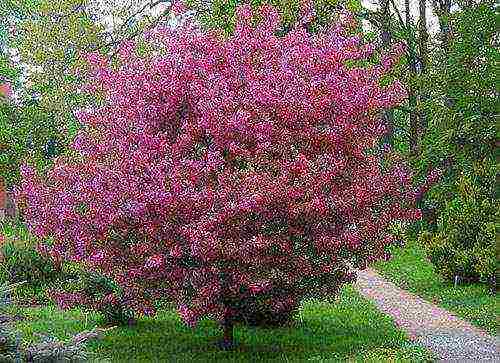 But apple trees are valued not only as fruit trees. The line of decorative trees is also represented by well-remembered trees. These species include the Royal, Nedzvetsky, Kitayka apple trees and more than 190 varieties of ornamental trees. The royal dwarf apple tree will adorn any composition. It is compared in bloom to sakura. These decorative apple trees are a decoration of the landscape. The victorious flowering lasts two weeks, but then the bush with cherry leaves is decorative. The fruits of the Royalty apple tree are inedible.
But apple trees are valued not only as fruit trees. The line of decorative trees is also represented by well-remembered trees. These species include the Royal, Nedzvetsky, Kitayka apple trees and more than 190 varieties of ornamental trees. The royal dwarf apple tree will adorn any composition. It is compared in bloom to sakura. These decorative apple trees are a decoration of the landscape. The victorious flowering lasts two weeks, but then the bush with cherry leaves is decorative. The fruits of the Royalty apple tree are inedible.
In this collection, we tried to present a little information on the apple world. But this is a small fraction of knowledge about this amazing tree of life.
Apple varieties at their summer cottage - video
The best winter varieties of apple trees for the Moscow region and central Russia: photo and description
The group of the best winter varieties of apple trees for the Moscow region and central Russia includes: Anise gray, Antonovka ordinary, Renet bergamot, Slavyanka, etc.

Winter grade Anise gray in the photo
Anise gray (striped)
The tree develops strongly, forming a powerful wide-pyramidal, rather dense crown. The main branches and their branches have a strong bond and withstand high yields. It restores the crown well. The most winter-hardy variety. Life expectancy is 60-80 years. There are also centenary trees.
This is one of the best winter varieties of apple trees for the Moscow region and the middle lane, high-yielding and fast-growing. Begins to bear fruit from the 5-6th year. The harvests are annual. During the period of initial fruiting, the yield is moderate, and at the time of full fruiting, it gives high yields: 300-350 kg of apples are often harvested from individual trees. Early flowering.
As you can see in the photo, this variety of apple trees, recommended for the Moscow region, has medium-sized fruits, sometimes small (60-75 g), flat-round, slightly conical, with a light green aromatic skin covered with a grayish-red smoky bloom or numerous reddish stripes:
The pulp is light green, juicy, sweet and sour with a spice taste.
Fruit picking - in the second half of September. They remain in prone until February.
Gray anise is the best variety of apple trees for fresh consumption and for technical processing (dough, jam, juices, confectionery); good for lobes.
The main variety in all areas, both rain-fed and irrigated orchards. Although it is drought-resistant, when irrigated, the size of the fruits and their yield increase dramatically.
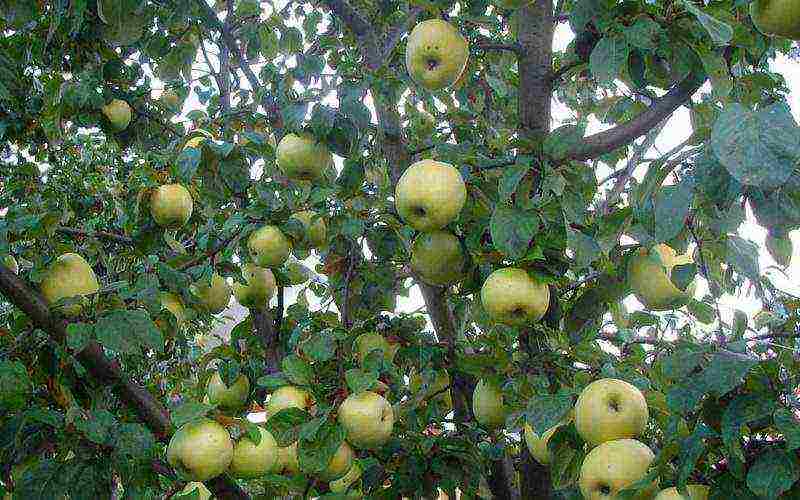
Apple tree "Antonovka ordinary" in the photo
Antonovka ordinary
The tree grows to a large size, forming a well-developed spherical crown with the main branches firmly attached to the trunk. Relatively frost-resistant. When describing this winter varieties of apple trees recommended for the Moscow region, it is worth noting that it grows and bears fruit better on moderately moist or irrigated soils.
Begins to bear fruit from 7-8 years. Productivity is high, with a rapid increase in the period of initial fruiting. This necessitates systematic fertilization.
Look at the photo - when describing this winter variety of apple trees, it is especially worth noting large (on average 120-150 g), round-cylindrical or conical with wide ribs, light yellow, with a strong aroma of fruits:
The pulp is white, juicy, sweet and tartaric and has a pleasant taste.
Blooming later. Fruit picking - at the end of September. Ripening in October - November. It is stored for 3-4 months, a valuable variety for fresh consumption and technical processing: it is used in large quantities for the preparation of marshmallows, candied fruits, marmalade, jelly, and apple dough; good for lobes.
Antonovka-kamenichka
This winter variety of apple trees, recommended for the Moscow region, differs from Antonovka ordinary in a smaller size of fruits with a blush on them and a more compressed crown of the tree. The yield is also good. Keeping quality - 4-5 months.
Renette bergamot
This winter variety of apple trees, grown in the middle lane, was obtained by IV Michurin from the seeds of Antonovka six hundred grams.
The tree is vigorous, with an oval, medium-dense crown, with strong main branches. In the conditions of the region it tolerates winter well. Begins to bear fruit from 6-7 years. Productivity is high: in the conditions of the region it is not lower than that of Anis gray. Medium early flowering.
Fruiting mainly at the ends of the fruit twigs, which must be taken into account when pruning.
Insufficiently resistant to scab, especially in rainy years or in low places.
Fruits are large or medium (average weight 120-125 g), onion-shaped, without ribs. The peduncle lacks the usual funnel, and some fruits have a tubercle here, like pears. When removed, the fruits are green, and when lying down, they acquire a yellow color, often with a pinkish "tan" on the sunny side. The pulp is firm, sweet and sour.
Late winter variety. Fruit picking - at the end of September. Fruits are stored for 6-7 months. They tolerate long-distance transportation well. Are consumed fresh.
Here you can see photos of the best varieties of apple trees, the description of which is given above:
What popular winter varieties of apple trees are best planted in the middle lane
Slav
This popular winter variety of apple trees for the middle lane was obtained by IV Michurin by crossing Antonovka vulgaris with pineapple. The variety is fast-growing, high-yielding. Begins to bear fruit from 4-5 years with a rapid increase in yields over the years.
The tree is of moderate development, forms a rounded, medium-spreading beautiful crown. Good winter hardiness. Blooming later.
Fruits are of average or below average size (average weight 60-65 g), bulbous-round, yellowish-green when removed, turn yellow in maturation. The pulp is juicy, tender, of excellent tartaric taste.
Fruit picking - at the end of September; consumer maturity - mid-November. Remains in prone for 5-6 months; carry long-distance transportation. The best dessert variety.
This is one of those apple varieties that are best planted in the suburbs on fertilized, moderately moist or irrigated soils. With a lack of moisture, it gives small fruits.
Skryzhapel
The tree is vigorous, with a pyramidal crown. Good winter hardiness. Begins fruiting in the 5-6th year. Productivity is high. Flowering - in medium terms.
At the age of initial fruiting, it gives moderate yields, and at the age of full yields, high.
Fruits are medium, flat-rounded, strongly ribbed, yellow-green, with dark red densely spaced solid and intermittent stripes.
This is one of the best varieties of apple trees for the middle lane with a dense, juicy, light green pulp of a sweetish taste, with a slight acidity. Fruit picking - at the end of September. They remain in bed for 6-7 months. Transport is well tolerated. Often they are affected by scab.
The variety is found in several forms, differing in yield, fruit size and color. When propagating, it is necessary to take cuttings from trees that are more productive, with large and better colored fruits.
Borsdorf-Chinese
The variety was bred by I. V. Michurin by crossing bulbous borsdorf with Chinese.
Trees of medium development. Average winter hardiness. In fruiting come from 5-6 years with a rapid increase in yields over the years. The yield is high: at the age of 12, it gives up to 130 kg per tree. Fruits are medium or below average size (average weight 60-70 g), rounded, smooth, greenish, yellow-green in maturation with whitish barely noticeable subcutaneous punctures, sometimes with a blush on the sunny side. The pulp is dense, juicy, sweet and sour, excellent taste with a slight spice.
Fruit picking - at the end of September. Consumer maturity in November - December. They remain in bed for up to 10 months. This is one of those varieties of apple trees, which are best planted in the suburbs, the fruits tolerate transportation well.
Higher yields and better marketable fruits are produced in irrigated orchards.
This collection contains photos of winter varieties of apple trees recommended for the Moscow region of central Russia:
Winter dessert
The variety was bred by S.P.Kedrin in 1935 by crossing the saffron Antonovka with the London pepin. The tree is winter-hardy, of medium vigor, with a flat-rounded crown. The variety is winter, its yield is high - in the 3rd year of fruiting, the tree gave 21 kg of fruit.
The fruits are rounded-conical, of medium size, weighing about 100 g (larger than anise), covered with a bright speckled-striped blush along the main yellow color of the skin in the form of shiny carmine stripes and broad strokes with a strong bluish bloom.
The pulp is light yellow, juicy fine-grained, dense, tender, excellent sweet-sour taste. Removable ripeness occurs in the first half of September. Keeping quality and consumption period are longer than that of anise and Antonovka vulgaris (from October to March). Recommended for testing in all areas of the middle lane.
Yellow ribbed
The variety was bred by S.P. Kedrin in 1935 by crossing Antonovka saffron with Pepin of London. The tree is winter-hardy, medium-sized, with a rounded crown. Typically winter variety. The annual yield is high. In the 3rd year of fruiting, the tree produces 19 kg of fruit.
Fruits are of medium size (larger than anise), conical in shape, with pronounced ribbing in the upper part of the fruit. The description of this variety of apple trees, recommended for the Moscow region, is quite consistent with the name: its fruits are yellow, with an orange-red tan on the sunny side.
The pulp is light yellow, juicy, dense, fine-grained, with an excellent sweet and sour taste. Removable maturity - in the second half of September. The fruits ripen in October - November and remain in maturation for a long time without losing high dessert qualities, having in this respect advantages over local varieties.
Further you can familiarize yourself with the photo, name and description of apple varieties, whose fruits ripen in autumn.
The best autumn varieties of apple trees for the Moscow region and the middle lane (with photo)
Scarlet anise (velvet, red, morocco)
An old variety, widespread in the middle lane.
Trees grow vigorously, forming a wide-pyramidal crown with dense branching. The main branches are firmly attached to the trunk and withstand high yields. They are distinguished by durability, high frost resistance (but somewhat less than gray anise) and drought resistance. The yield is high. In the period of initial fruiting (5-10 years) it gives moderate yields, in the period of the highest yields (20-50 years) - high. Some trees give up to 200-300 kg of fruit. They begin to bear fruit from the 5-6th year. Early flowering.
This autumn variety of apple trees for the middle lane has medium-sized fruits (60-70 g), very beautiful, flat-rounded, slightly conical, with a blurred red blush and a bluish bloom, fragrant. The pulp is greenish-white, sometimes with a pink tint, dense, juicy. The taste is sweet and sour, spicy.
Fruit picking - late August - early September. They remain in bed for 3-4 months. They tolerate long-distance transportation well. Are consumed fresh; good for technical processing (jam, marshmallow, etc.) and lobes.
Fruits in prone are sometimes affected by bitter rot (pepper), so they should be checked more often during storage. With a high drought resistance, the variety in irrigated orchards gives higher yields of the best marketable fruit.
Malt crusade
The trees are vigorous, with an elongated oval-rounded medium-dense crown and straight main branches. In mature trees, under the weight of the harvest, the crown becomes spreading. The variety is winter-hardy. The yield is high. Begins to bear fruit from the 6-7th year. Medium early flowering. At the age of initial fruiting, it gives moderate yields, and at the time of full fruiting - high yields, surpassing many local varieties. Individual trees produce 250-350 kg of fruit.
This one of the best autumn varieties of apple trees for the Moscow Region has large fruits (average weight 120 g), flat-rounded, slightly conical in the upper part, wide-ribbed.
The skin is yellow, matte, thick; on the sunny side, it is covered with a continuous blush, along which red stripes run. Large subcutaneous points are scattered throughout the fetus, giving it "marbling".
The pulp is yellowish-white, medium-dense, moderately juicy, good sweet and sour taste.
Fruit picking - late August - early September. Remain in bed for 2-2.5 months. They tolerate transportation well. They are consumed fresh and for technical processing. Good for lobe.
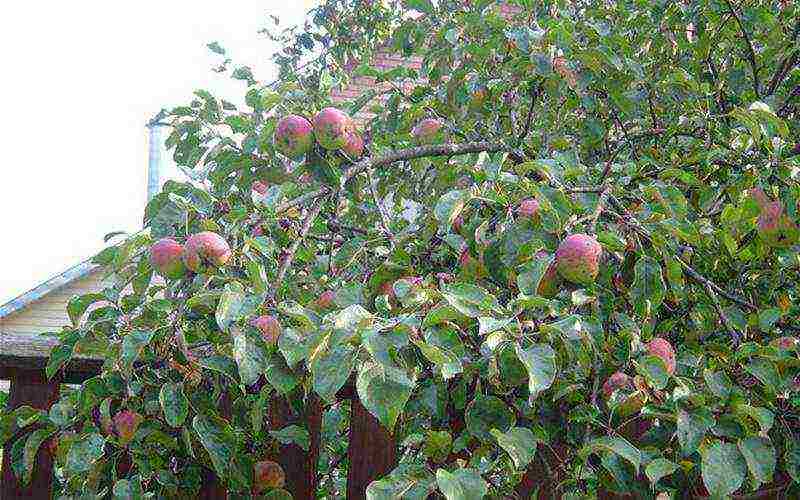
Apple tree "Borovinka" in the photo
Borovinka
Central Russian variety, ubiquitous in the middle lane.
Medium-sized trees with a spherical, medium-dense crown covered with dark green foliage. The main branches sometimes break off under the weight of the fruit. Therefore, by the time of full fruiting, they should be fastened by tying. The variety is winter-hardy. The yield is high, annual. Begin to bear fruit from the 5th-6th year, sometimes earlier, with a rapid increase in yield. During the period of the greatest harvests, 300-350 kg of fruits are often harvested from individual trees. Early flowering. Good pollinator for many varieties.
Reacts well to fertilizers and irrigation.
In low places, as well as in rainy years, the fruits are affected by scab.
Pay attention to the photo - this variety of apple trees, recommended for the Moscow region, has medium-sized or large fruits (average weight 80-100 g), round or flat-round, smooth or with weak ribbing:
The skin is yellow-green, smooth, shiny, covered with pale red or carmine broad stripes throughout the fruit. The subcutaneous points are clearly visible. The pulp is yellow-white, juicy, with a pleasant tartaric-sweet taste.
Fruit picking - end of August. They are consumed fresh and for technical processing. Transport is well tolerated. They remain in bed for about 2 months.
Below you will find out what other varieties of autumn apple trees can be planted on the site.
The most productive autumn varieties of apple trees: description with photos
White twist (pink twist, twist, half twist)
Trees of this variety of autumn apple trees for the Moscow region are vigorous, durable, with a wide-spreading medium-dense or sparse crown. The variety is highly winter-resistant, fruitful.
Begin to bear fruit from the 6-7th year. Medium early flowering. At the age of initial and increasing fruiting (7 - 20 years), they give moderate yields, and at the age of the largest yields, they are high, almost like Anise and Malta cross.
Fruits are of medium size (average weight 75-100 g), flat-rounded or round, smooth, with a slight depression for the peduncle, sometimes without it. The skin is snow-white, shiny, covered with faint pink stripes, strokes or continuous erosion. The pulp is white, juicy, sweet and sour, slightly astringent, with a mediocre taste. Fruits are often affected by scab and fruit rot.
Fruit picking - late August - early September.
It is consumed fresh and for technical processing (gives a good quality dough); also suitable for lobes. It lasts about one and a half months. Not suitable for long-distance transportation.
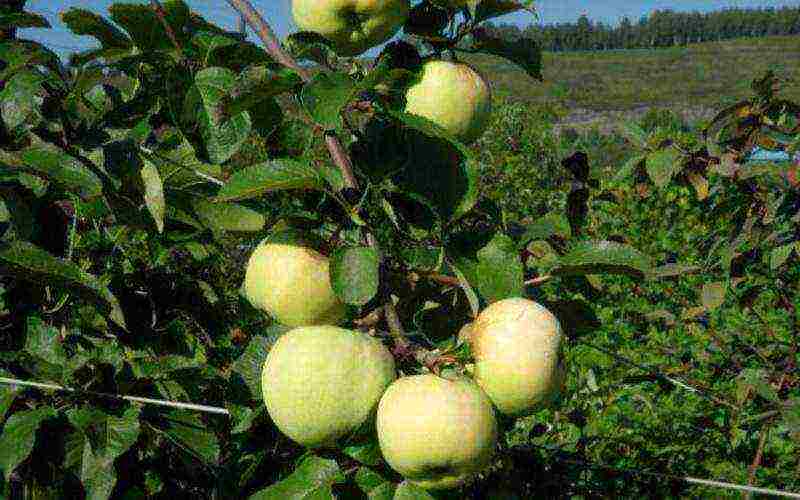
Apple-tree variety "Antonovka six hundred grams" in the photo
Antonovka six hundred grams
The trees are powerfully developed, with an oval-rounded, medium-dense crown covered with large leaves.
The variety is winter-hardy, the yield is high. Blooming later. At the age of 24-30 years, it produces an average of 100-150 kg of fruit per tree, and 300-500 kg are removed from individual mature trees. Fruiting from 7-8 years.
The photo shows that this autumn variety of apple trees for the Moscow region has very large fruits (average weight 250-300 g), onion-oval, ribbed, yellowish-white:
The pulp is juicy, white, fine-grained, tender. The taste is sweet and sour.
Fruit picking - in the middle of September. The fruits are consumed fresh and for technical processing. Unsuitable for long-distance transportation. They remain in bed for about 2 months.
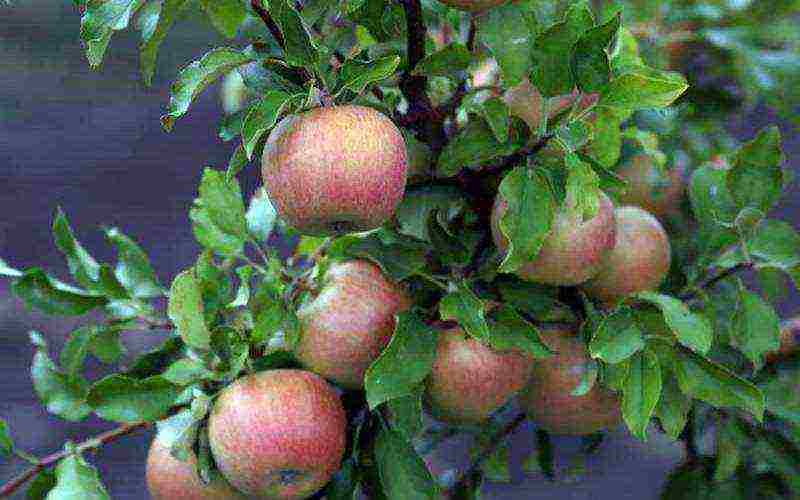
Apple-tree variety "Bellefleur-Chinese" in the photo
Bellefleur-Chinese
The trees are vigorous, with an oval-rounded medium-dense crown. Average winter hardiness, good yield. Begin to bear fruit from the 7-8th year.
During the period of initial and increasing fruiting, the yield is moderate, and at the time of full fruiting, it is high. Flowering - in medium terms.
As you can see in the photo, this autumn variety of apple trees for the middle lane has large fruits (average weight 150-200 g), rounded, slightly ribbed:
The skin is golden yellow, shiny, with bright red stripes. The pulp is white, juicy, fine-grained, delicate, aromatic, excellent, with a slight acidity and spice taste.
Fruit picking - in the first half of September. The fruits are stored in maturation until December. They tolerate transportation well. The best dessert variety.
Kitayanka Sanina (ranetka Sanina)
Volga variety of large-fruited Chinese. Distributed throughout the middle lane.
Trees grow strongly, forming a rather dense oval-rounded crown. Winter hardiness and productivity are high. Drought tolerant. Begin to bear fruit from 5-8 years (later than other Chinese women). During the period of initial and increasing fruiting, it gives moderate yields, and during the period of full fruiting - high.
Fruits are larger than many Chinese varieties (average weight 25-30 g), have an oblong-oval or ovoid shape. The skin is green-yellow, covered almost over the entire surface with a blurred red blush. The pulp is dense, tough, sweet and sour taste.
Fruit picking - at the end of August. Can persist for 2-2.5 months. They tolerate transportation well.
The fruits are mainly used for technical processing (confectionery, jams, juices, wine, etc.).
There are trees with a rounded, slightly spreading crown and more pyramidal. The former usually enter fruiting earlier and their yield is higher. When propagating a variety, cuttings must be taken from productive trees.
Look at the photos of apple varieties described above:
What good varieties of autumn apple trees are better to plant in the suburbs
Volga Chinese No. 1 (ranetka)
The most widespread variety of Kitayka in the middle lane, found in all gardens of the region.
Trees develop strongly, forming an oval-rounded, somewhat spreading crown. They are characterized by high winter hardiness and good annual productivity. Begin to bear fruit from 3-4 years.
Fruits are medium (for Chinese women), round or oval, with a yellow skin, covered almost over the entire surface with a blurred blush, with a non-falling calyx. The pulp is dense, juicy, sour taste. They go for technical processing. Cold processing yields the best seed for rootstocks.
This variety of autumn apple trees for the middle lane is the best representative of the group of Volga Chinese women, similar to it in morphological and biological characteristics.
Russian rosemary
The trees are highly developed, with a medium-dense oval-rounded crown. Average winter hardiness. The yield is good. Fruiting - from 6-7 years Flowering - in the middle. The flowers are frost resistant
Fruits are large (average weight 120-150 g), round or oval-round, smooth, light yellow, with a slight blush on the sunny side. The pulp is juicy, medium-dense, granular, with a weak aroma. The fruits of this one of the best varieties of apple trees for the Moscow region taste sweet and sour, slightly spicy.
Fruit picking - in the middle of September. Remain in bed for 2-2.5 months. They endure transportation well. The best dessert variety. Recommended for production testing.
Spartacus. The tree is vigorous with a wide-pyramidal crown. Highly winter-hardy and fruitful: in the 3rd year of fruiting, 15 kg were obtained from a tree. Fruits are large, weighing 200 g with an average weight of 110-120 g, round or flat-rounded, obtuse ribbed. The color is yellowish, with a pink-red striped blush. The pulp is creamy, juicy, of medium density, excellent sweet-sour taste, aromatic. Fruit picking - in the first half of September. Late autumn variety. Zoned in all zones.
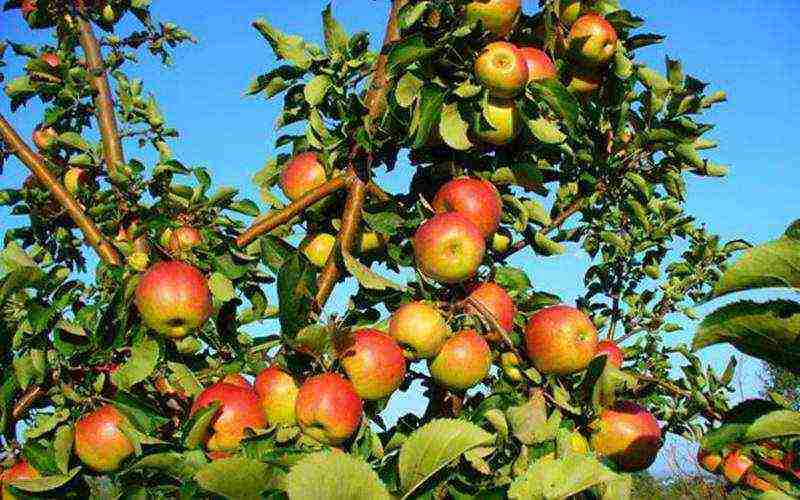
Apple-tree variety "Zhigulevskoe" in the photo
Zhigulevskoe
The tree is vigorous, winter-hardy and more productive. Fruits are very large, average weight 150, the largest - 250 g, flat-round shape.
Look at the photo - in this one of the best varieties of apple trees, the main color of the skin is bright golden yellow, the integumentary color is bright carmine red, blurred, sharply outlined and prominent against the main background:
The pulp is creamy yellow, juicy, of medium density, excellent sweet-sour taste. Harvesting maturity occurs in late August - early September, with a consumption period from September to November.Recommended for testing in all areas.
Kutuzovets
Trees of medium vigor, with a round, medium-dense crown. Their winter hardiness is high. The variety is typically winter, fruitful, with a poorly expressed frequency of fruiting. The main crop is located mainly on ringlets. The yield of the mother tree in the second year of fruiting was 10 kg, and in the next 2-4 years - up to 20 kg.
Flowering takes place in medium terms and coincides with Anis gray, Renet bergamot and Borovinka. The flowers of this apple variety for central Russia are relatively frost-resistant.
The fruits adhere firmly to the branches, are more resistant to scab and moth than Skryzhapel. They are more resistant to putrefactive diseases both in the garden and during winter storage compared to other varieties. Fruits are of medium or above average size, with an average weight of 100-110 g, covered with a striped, merging blush along the main yellow field, with numerous rather large subcutaneous punctures, which give the fruit a peculiar "marbling".
The pulp is whitish, dense, juicy, fine-grained, sweet-sourish, with a weakly expressed spiciness of excellent taste (higher than that of Skryzhapel). Removable ripeness of fruits - at the end of September. They ripen well in maturation in November - December, acquiring their characteristic qualities by this time. They can be stored in bed until spring.
Volzhsky saffron
Bred by S.P.Kedrin in 1935 by crossing Antonovka saffron with Pepin of London. The tree is medium-sized. Winter hardiness of the variety is high, not lower than that of standard varieties - anise and Borovinka. The yield is good, annual.
Fruits are medium in size, with an average weight of about 100 g, and the largest about 130 g, flatly rounded, with noticeable ribbing and tubercles at the calyx, like in Calvilia. On their main yellow color, a bright speckled blush with prominent strokes is blurred, which gives them an attractive appearance. This is one of the best varieties of apple trees for central Russia with a creamy yellow, juicy, dense, not coarse pulp of sweet and sour, excellent taste.
Fruit picking - in the first half of September. Shelf life is longer than that of Antonovka vulgaris and anise.
The following is a description of varieties and photographs of varieties of apple trees that bear fruit in summer.
The best summer varieties of apple trees for the Moscow region and the middle lane
Grushovka Moscow (Skorospelka)
An old Russian variety, widespread everywhere.
Trees reach large sizes, form an elongated-oval crown with strong and thick main branches of medium density, covered with light green long leaves. Frost resistance high Yield durable. A fast-growing variety - begins to bear fruit from the 5th-6th year with a rapid increase in yield; at the age of full fruiting (20-50 years), yields of 200-250 kg per tree per year are not uncommon. Early flowering.
Fruits are small, flat-conical, with a thin shiny skin covered with pink-red stripes. The pulp of this one of the best summer varieties of apple trees for the middle lane is yellow-white, juicy, soft, with a pleasant sweet and sour taste. The fruits begin to ripen in early August. Their maturation is uneven.
Removal of fruits - in 2-3 doses, in order to avoid shedding.
Not suitable for long-distance transportation. Can persist for 1-1.5 months. Consumption - fresh and for technical processing.
Pouring white (Pudovshchina, Dolgostebelka)
Trees of moderate growth, forming a spherical, medium-dense crown with light green foliage. The variety is winter-hardy and productive, especially on strong soils. Strongly affected by scab, especially in low places. Begins to bear fruit from the 5-6th year. Medium early flowering.
The fruits of this summer variety of apple trees, recommended for the Moscow region, are of average or below average size, round-conical, light yellow. The pulp is white, fine-grained, sweet and sour taste. Ripen in the second half of August. The fruits last for about a month, but quickly deteriorate in taste.Transport is not well tolerated. They are consumed fresh, they can also go for technical processing.
Alabaster (Papirovka)
The spread is small. The trees are vigorous, with an oval-rounded crown covered with light green leaves. Average winter hardiness. It is more resistant to scab than White filling. The yield is good, almost yearly. The variety is early-growing, early summer. Fruiting in 4-5 years. Blooms in medium terms.
Fruits are of medium size (about 80 g), round-conical or oval, with wide ribs, on one of which a seam stands out (a fold is the main distinguishing feature), light yellow, with a bloom and green subcutaneous dots. The pulp is white, juicy, of excellent tartaric and sweet taste.
Fruit picking - at the beginning of August. Consumption - fresh. They are stored for about a month. This is one of those apple varieties for the Moscow region, which are recommended to be grown for quick consumption, since the fruits are not transportable. A good dessert variety.
Malt bagaevsky
The trees are vigorous, with a broadly spreading, medium-dense crown. Their winter hardiness is good, not lower than Anis scarlet and other winter-hardy varieties. Begins to bear fruit from 6-7 years. Productivity is high: in the period of full fruiting, it gives on average about 80 kg per tree, and from individual trees - 150-200 kg or more.
Fruits are of medium size, but larger than Anise scarlet, flat-rounded, with a white skin covered with a bright crimson-red blush and a light bloom, very beautiful.
The pulp is juicy, tender, white, good sweet and sour taste. Fruits ripen in mid-August. They tolerate transportation well. They persist for about 40 days. Are consumed fresh.
Next, you will find out what other good varieties of apple trees are recommended for the middle lane and the Moscow region.
Below is a description of what other varieties of apple trees are best planted for the summer harvest.
What other varieties of summer apple trees can be planted on the site
Chinatown golden early
Trees of medium development, with a pyramidal crown. They are characterized by high winter hardiness. The variety is early summer and early-growing. You enter fruiting in the 4th or 5th year. The yield is growing rapidly. At the time of full fruiting, it gives medium to good yields. This summer variety of apple trees blooms early for the middle lane. Fruits are small (average weight 30-40 g), roundish, golden yellow. They are often poured. The taste is sweet, pleasant.
Fruit picking - late July - early August. They persist for 2-3 weeks. They are consumed fresh and for technical processing.
Kopylov's turnip (Red turnip). Trees of moderate growth, with long main branches, forming a broom-shaped crown, spreading out in old age (need support). Average winter hardiness. It is quite resistant to scab. Begins to bear fruit from 5 to 6 years. The yield is average or good, almost annually. Early flowering.
Fruits are medium-sized, onion-shaped, with a dense dark purple continuous blush and a bluish bloom, through which fuzzy white subcutaneous dots shine through. The pulp is greenish-white, juicy, with a mediocre sweet-sour (insipid) taste.
Fruit picking - in the middle of August. They persist for about 20 days. Not transportable. Are consumed fresh.
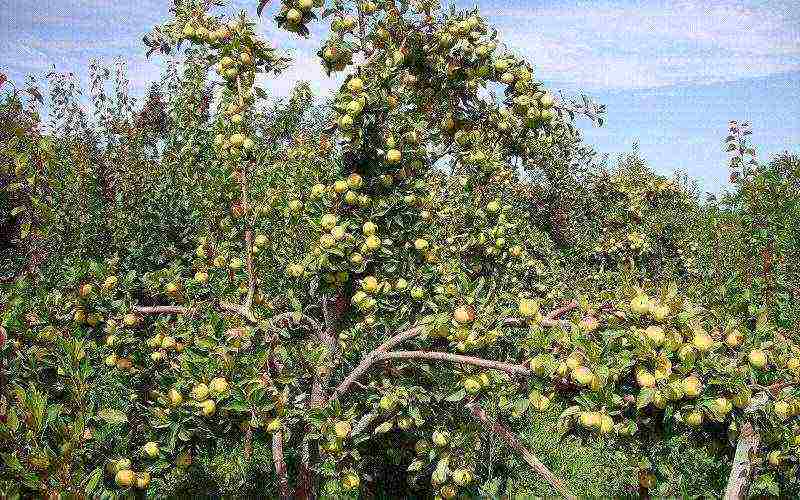
Apple-tree variety "Arkad sugar" in the photo
Arcad sugar (smoky)
Slightly distributed. The trees are vigorous, form an oval-rounded crown with strong main branches.
Resistant to frost. The yield is average. Begins fruiting from 6-7 years.
Look at the photo - this variety of apple trees for central Russia has below average fruits, round-conical or round-cylindrical, yellow-green with an orange-reddish tan:
The pulp is whitish, loose, juicy, sweet honey taste.
Fruit picking - late July - early August; but the fruit is ready for consumption long before ripening. They can be stored for about 3 weeks. Not transportable. Fresh consumption.
Papirovka's daughter (Volzhsky pouring)
The tree is medium-sized.Winter hardiness is not lower than that of local standard varieties, anise, etc. The yield is good, annual. The mother tree in the 3rd year of fruiting gives about 15 kg of fruit.
Fruits are of medium size, the size of Alabaster, with an average weight of about 80 g, round or flat-round shape, weak wide ribbing, sometimes with a "seam" like Alabaster. The skin color is greenish-yellow, with a golden tan and noticeable large subcutaneous dots.
The pulp is creamy, tender, juicy, sweet and sour, excellent taste. Ripening in the first half of August. This is one of the best varieties of summer apple trees, recommended for the Moscow region, resistant to scab.
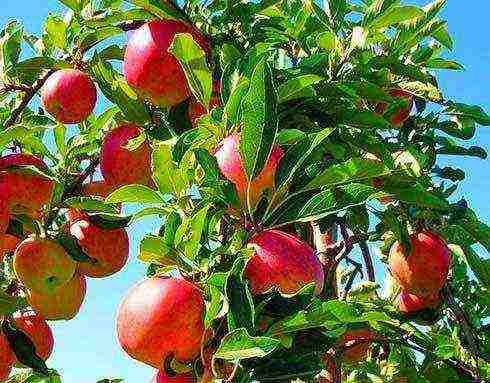
The best varieties of apple trees
Today I would like to share with you information from my sister, who works in a fruit nursery. It will be about the best apple varieties to date. Every year, new varieties are bred, which in their qualities are significantly superior to those that once occupied a dominant position in our gardens.
Each season, varieties appear with improved productivity indicators, resistance to common diseases. And the task of the gardener is to rejuvenate his garden in time, achieving optimal yield characteristics.
All varieties of apple trees can be divided into tasty, aging, and resistant.... These three indicators are what breeders dream of uniting. And I must admit that every year interesting, noteworthy specimens appear on the market. Do not be lazy to experiment, plant, observe, test! It is very interesting…
In any case, it is better to be among those who enjoy new discoveries. Even failures in this case will be experiences, although I doubt you will perceive them as failures.
New promising apple varieties
Yes, the old apple orchard amazes with flowering in the spring, pleases the eye, but most often the harvests in it are far from ideal. In one good year, there are five mediocre, if not completely barren. And the quality of the fruit is far from normal.
Upgrade your apple orchard: if you purchased a plot with old apple trees, then it most likely makes sense to completely renovate the garden, rather than trying to get something valuable from the trees. Yes, there are old trees on our site, but they mainly serve for shade, it is comfortable to sit under them on a hot summer day. But there are no harvests from them ...
A neighbor diagonally from us planted a couple of years agoapple-tree variety Orlovskaya striped and gets incredibly tasty apples with excellent yields from it. He also has planted grade Cinnamon new, which begins to bear fruit early, is quite fruitful and immune to scab.
We are happy on our site Canadian Melba, her apples are incredibly tasty, moderately sweet, slightly sour, juicy and optimally firm. In the coming season, we are going to plant two more seedlings - Orlinka and Early scarlet Are fast-growing varieties with high yields.
Most modern apple varieties have dwarf properties, this is important, since height is most often not needed, and it is difficult to harvest. The new varieties are compact, disease resistant and at the same time very productive. Imagine a bush literally covered with apples - this is the characteristic modern apple tree.
The best varieties of apple trees
Liberty, Golden Resistant, Baritone, Enterprise, Ligol, Krasa Sverdlovsk, Lovely Red, Green Blues, Askold, Williams Pride, Champion, Capital Red, Radogost, Bullfinch.
These varieties are now the best, and if you decide to update your apple orchard, then pay attention to them. Look in your nurseries, order seedlings if you don't have such varieties.
Video - early varieties of apple trees
Next, I will list the most successful varieties of apple trees., which are most often taken in the nursery from my sister:
Apple variety Medunitsa - summer residents are very fond of, because the fruits are sweet, truly honey. You can eat directly from the branch, as it ripens.In addition, apples are great in the refrigerator or cellar until the New Year holidays.
Medunitsa begins to bear fruit in the fourth year, yields are usually large, annual, without gaps, as the plant ages, the yield decreases. a distinctive feature of the variety - it is not subject to rot and scab. I advise you to pay attention if you like sweet apples!
Legend is also good from sweet varieties... The yield is also large, the apple tree bears fruit every year, it is resistant to cold weather, and is immune to scab and rot.
I also recommend paying attention to the following scab resistant varieties:
Sun, Imrus, Bolotovskoe, Anniversary of Moscow, Oryol woodland, Freshness, Kandil orlovsky, Start, Health, Rozhdestvenskoe
By the way, if you are wondering if you need to pick flowers in the first years of apple blossom, then read this material of mine -

